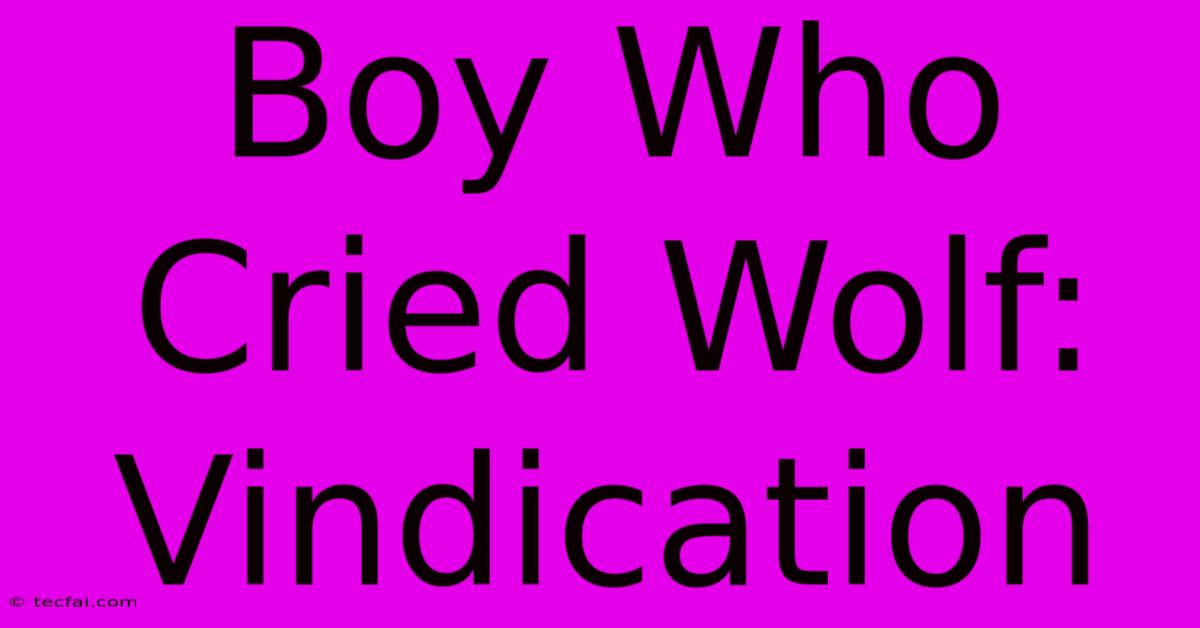Boy Who Cried Wolf: Vindication

Discover more detailed and exciting information on our website. Click the link below to start your adventure: Visit Best Website tecfai.com. Don't miss out!
Table of Contents
The Boy Who Cried Wolf: Vindication – A Retelling for the Modern Age
The classic fable of "The Boy Who Cried Wolf" teaches a valuable lesson about honesty and the consequences of deception. But what if we revisited the story, exploring the possibility of vindication? What if the boy wasn't lying, and his cries for help were tragically ignored? This retelling delves into that very possibility, examining the themes of unheard voices, institutional failure, and the importance of believing victims.
The Weight of Unbelieved Truths
The original tale portrays a shepherd boy who repeatedly cries "Wolf!" as a prank, leading to his eventual demise when a real wolf attacks and no one comes to his aid. However, we can reinterpret the narrative. Imagine a scenario where the boy truly saw wolves – perhaps smaller, less immediately threatening wolves, or even just signs of their presence – but his warnings were dismissed as exaggerations or fabrications. His repeated pleas, initially ignored, gradually eroded the trust of the villagers. This isn't about excusing potential falsehoods; it's about understanding the devastating effects of systematic disbelief.
The Crushing Power of Disregard
This reimagining allows us to explore a crucial societal problem: the disbelief faced by victims, particularly when their claims are repeated or perceived as unusual. The boy's cries represent the experiences of many individuals whose warnings about abuse, neglect, or danger are ignored because they've cried wolf before – even if those cries were genuine. This disregard can have severe consequences, leading to escalated harm and, in extreme cases, tragedy.
Institutional Failures and Systemic Issues
Furthermore, this revised fable highlights the failings of the village's systems and leadership. The adults' lack of investigation, their preference for dismissing the boy’s concerns, and their ultimate failure to act represent a broader issue of institutional blindness and inaction. This is not simply a moral failing of individuals but a systemic flaw that allows harm to persist. Who is responsible when a system fails to protect its members?
Lessons Beyond the Fable
The story's updated interpretation moves beyond a simple moral lesson about honesty. It prompts us to critically examine the structures and attitudes that prevent us from hearing and believing victims. It challenges us to consider:
- The importance of due diligence: Instead of immediate dismissal, a thorough investigation into reported incidents is crucial.
- The power of empathy: Understanding the perspective of the person making the claim is essential for effective response.
- The need for systemic change: Institutions must actively work to create environments where victims feel safe and believed.
Finding Vindication in Understanding
The vindication for the boy doesn't necessarily mean a reversal of the original outcome. It lies in the acknowledgment of his suffering and the subsequent changes made to prevent similar tragedies. The villagers, having learned a hard lesson, might implement new protocols for responding to warnings, focusing on investigation rather than immediate dismissal. This could include developing clearer channels for reporting, providing support for victims, and fostering a culture of belief.
Ultimately, the re-imagined "Boy Who Cried Wolf: Vindication" shifts the focus from a simple cautionary tale to a powerful commentary on the importance of listening, believing, and acting to protect the vulnerable. It serves as a call for systemic change and a reminder that dismissing cries for help, even if repeated, can have catastrophic consequences.

Thank you for visiting our website wich cover about Boy Who Cried Wolf: Vindication. We hope the information provided has been useful to you. Feel free to contact us if you have any questions or need further assistance. See you next time and dont miss to bookmark.
Featured Posts
-
Gambino Cancels Australia Nz Tour
Nov 22, 2024
-
Simon Ekpa Faces Nigerian Extradition
Nov 22, 2024
-
Winston Prepares For Browns Steelers Clash
Nov 22, 2024
-
Mountain Culture Cummins Investment
Nov 22, 2024
-
Seventh Eruption Iceland Volcano
Nov 22, 2024
